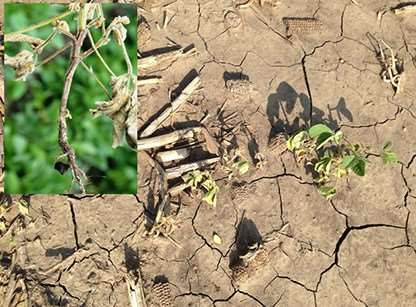Potato Leafhopper: Pest Profile
Adult potato leafhoppers are approximately 1/8” in length and have translucent wings that cover their bodies like a tent when at rest. In general, potato leafhoppers are a green to light green color (Figure 1). The nymphs of the potato leafhopper vary in size and resemble the adults with the exception of not having wings. Nymphs that are in the later developmental stages will have observable wing pads present, but they are noticeably smaller than fully developed wings. The nymphs and adults of potato leafhoppers have specialized hind legs that allow them to jump long distances. Both the nymphs and adults feed using piercing-sucking mouthparts. Potato leafhoppers do not have the dark markings on the head that are characteristic of aster leafhoppers.
Plant Injury
It is important to scout fields for potato leafhopper nymphs and adults, because both are capable of causing injury to alfalfa. As mentioned, potato leafhoppers have piercing-sucking mouthparts that are used to remove fluids from the vascular tissue of the alfalfa plants. The potato leafhoppers use their mouthparts to probe the plant, which disrupts the cells within the leaves. This cell disruption results in characteristic leafhopper feeding injury that is referred to as “hopper burn” (Figure 2). Large populations of potato leafhoppers will cause stunted plants and may lead to significant losses to the tonnage and quality of the alfalfa crop.

Figure 2. Hopper burn symptoms on alfalfa. Credit: A. Varenhorst
Scouting
When scouting for potato leafhoppers, the first thing you will need is a sweep net. Sample the field edges because this is where potato leafhoppers tend to be more of an issue. While walking in a “W” or “Z” pattern, swing the net in a 180-degree pendulum swing 25 times. Each of the pendulums (left to right) counts as a single sweep. Count the total number of nymph and adult potato leafhoppers present in the net. Next, measure the height of the alfalfa plants. Economic thresholds for alfalfa are based on plant height; 0 to 12 inches tall (Table 1), 12 to 18 inches (Table 2), and 18 to 24 inches (Table 3).
Management
The potato leaf hopper is considered a sporadic pest, and is more likely to be a problem when other abiotic stresses such as drought or heat stress are also present. There are three management recommendations for potato leafhoppers in South Dakota.
- Plant resistant varieties: Plant resistant alfalfa varieties (alfalfa that has glandular hairs or trichomes). The hairs present on the stems and leaves of these varieties prevent the adults from effectively feeding, and the nymphs may become caught and will eventually starve.
- Cut alfalfa once detected: Cut alfalfa when a potato leafhopper infestation is detected. Although this is capable of disrupting potato leafhoppers and forcing them to other plants nearby, there is the chance that populations will re-infest the alfalfa regrowth.
- Use insecticides: Use of insecticides to reduce potato leafhopper populations and reduce the chances of injury to the developing alfalfa. The economic thresholds for potato leafhoppers are dependent on the value of hay, cost of insecticide application, and the size of the plant.
Click here to see more...